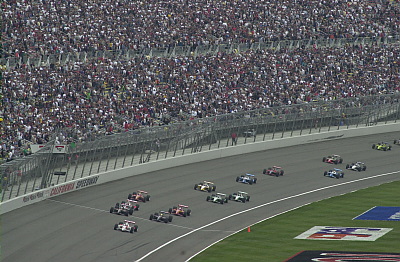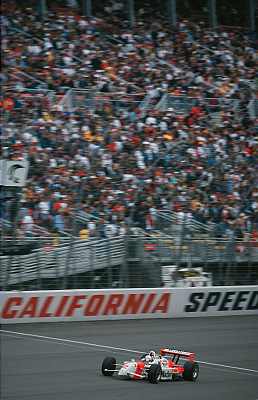The Way It Is/ What Indy car racing lacks
by Gordon Kirby Last week on Michael Knight's one-hour weekly radio show 'The Race Reporters', I enjoyed a healthy discussion with host Knight, Robin Miller and Dario Franchitti about the depleted state of Indy car racing today and some of the historical blunders that pushed the sport into its long decline over the past fifteen years. Knight started his radio show a couple of months ago and features a star driver every week from across the wide range of American motorsports plus a panel of two or three racing writers with particular knowledge of the driver's career or area of expertise.
Check out last week's 'Race Reporters' show
Last week on Michael Knight's one-hour weekly radio show 'The Race Reporters', I enjoyed a healthy discussion with host Knight, Robin Miller and Dario Franchitti about the depleted state of Indy car racing today and some of the historical blunders that pushed the sport into its long decline over the past fifteen years. Knight started his radio show a couple of months ago and features a star driver every week from across the wide range of American motorsports plus a panel of two or three racing writers with particular knowledge of the driver's career or area of expertise.
Check out last week's 'Race Reporters' showAt the end of last week the IRL announced its 2010 schedule. The series will make another experimental sortie to a new venue in the South at Birmingham, Alabama as well as opening its season in Brazil but the IRL continues to show its deeply provincial roots by ignoring first-class road circuits like Road America and Laguna Seca as well as one-mile ovals like New Hampshire and Phoenix, tracks that are perfect for Indy cars. And of course it looks like Milwaukee joins the 500-mile races at California and Michigan which have gone forever from Indy car racing, all three races terminally damaged by the CART/IRL civil war.
In Kentucky on Saturday night Ryan Briscoe took the IRL point lead from Scott Dixon and Dario Franchitti after Briscoe scored his second win of the year. The IRL's latest aero rules and push-to-pass addition helped keep the field together and made for more side-by-side racing than in most recent oval races. IRL officials and teams gushed enthusiasm over the modified rules but this kind of Indy Lights-style racing has little appeal to the fans as the swaths of empty seats in Kentucky and miserable TV ratings demonstrate. To turn around Indy car racing's slide into irrelevancy the IRL needs to transform its thinking but the series and its competitors have lost the plot. They are racing for themselves, not the wider world. Will they ever wake up and realize that Indy car racing's formula desperately needs a complete rewrite? Unlikely, it seems.
Meanwhile, the latest September issue of Motor Sport is on the newsstands in the UK this week and will be delivered over the course of this month to subscribers and newsstands in the United States and around the world. Motor Sport plans to speed-up its delivery of the magazine here in the USA next year by printing the Stateside copies in this country. We'll also kick-off Motor Sport's first serious American promotional campaign at this month's Monterey Historics and Pebble Beach Concours. We'll be distributing magazines on the Monterey Peninsula and will have a Motor Sport stand at Laguna Seca where I will interview some great drivers from the past.

© LAT USA
Of course, de Ferran's and Gugelmin's record laps set the stage for the demise of Indy car racing as we once knew it. Through the turn of the century CART was annually restricting the boost and messing with the wings and aerodynamics as they tried to slow-down the cars. The IRL went even further, cutting horsepower dramatically and increasing the overall drag and downforce of its cars. Most people seem to agree that the IRL went too far but there was no question that CART's Indy cars were at the limits of human control.
The proof came at the 1.5-mile high-banked Texas superspeedway in 2001 when the drivers began to suffer dizzy spells. Some even blacked-out. And too, both Cristiano da Matta and Gugelmin survived giant accidents, Gugelmin's car recording an impact of no less than 113g. After much debate and hand-wringing the race was cancelled with the crowd still streaming into the track. It was one in a long series of debacles that led to CART's implosion a few years later. De Ferran agrees that speeds had to be reduced a little but he's one of many participants and observers who believe the IRL went too far.
"Frankly, on some tracks, it was a little too much," de Ferran comments. "The speeds we did in those days were a little bit too high. When it was all going good it was great. But when something went wrong in that environment it was too much. There were some pretty big accidents and people got hurt. So to some extent, particularly on some tracks, we needed to back-off a little bit.
"I was in agreement with the initiative, or the thought, that that's what we should have done, and that's what we did. Of course, there are plenty of different opinions on how you go about doing that. Whether we've gone too slow with the new generation of cars, or whether it's necessary in today's world, I don't know.
"My perspective on the question as a whole is the following," de Ferran went on. "The faster the car, the more challenging it is to a driver, essentially because you have less time to perform the same maneuvers. That's really the bottom line. Whether the speed comes from the cornering speed or from having more power, the more challenging it is for the driver.
"I always thought that what defined an Indy car was this slightly insane combination. It's not for everyone. Not quite everyone can get ahold of it. I think when fifty percent of the people think this is a bit crazy, that is an Indy car. Then you are getting close to the right mix for an Indy car. That was one of the key differentiations in my mind between a Formula 1 car and an Indy car. To me, an Indy car was always a slightly insane car to drive.

© LAT USA
"And that's what you want. You need to get to the point where it's not for everyone. The public that's watching Indy car racing needs to realize that they're watching a select few drivers that not only are able, but are also willing to drive these cars."
Gugelmin agrees with de Ferran. "When I watch Indy cars on TV these days, it doesn't feel as good as it used to," Gugelmin remarked. "Back in the nineties those CART cars looked fast and sounded great on TV. But IRL cars look slow, even on TV, and they look big, too. I hear from the drivers that when they go to a street circuit the cars are heavy and hard to turn and horrible to drive, and that's bad. And they don't have that nervousness about them. A formula race car has to be twitchy and alive and those cars don't look alive.
"After we ran that 240 mph lap in 1997 they changed the rear wing the following year just to make the racing better. I wasn't really happy with that. I felt as a racer that it took too much away from the cars. It was such a challenge to make a car balanced with those little wings on a superspeedway and to make the car run as loose as you could for qualifying. That's how you got speed out of it.
"I think we probably lived through the best time of racing," Gugelmin adds, "because the speeds were high, the cars sounded good and looked good, and the racing was very good."
As we are all painfully aware today's Indy cars are so underpowered and overdragged that they run flat-out around the bottom of most oval tracks. Passing is extremely difficult and many races degenerate into follow-the-leader pursuit matches not unlike most street or road races.
"They tried to spice it up in Champ Car and now in Formula 1 and IRL by having a soft tire and hard tire," Gugelmin noted. "But even that didn't help much."
The IRL hopes to introduce a new turbocharged Indy car formula in 2012. The details of both the engine and aerodynamic formula are not yet clear. Horsepower probably will be increased a little for road courses, but not by much, and may be reduced for the ovals. The chassis is expected to remain a Dallara spec car and it's unlikely the 2012 formula will produce a car with much more pizazz and appeal than the current cars.
Unfortunately, the spectacular level of performance we saw in CART's Indy cars from the turn of the century and over the previous ninety years of Indy car racing's history under AAA, USAC and CART appears to have vanished from the IRL's purview. Those of us who had the pleasure of watching Indy car racing's great cars and drivers from trackside will always treasure the memories.
Auto Racing ~ Gordon Kirby
Copyright 2009 ~ All Rights Reserved
Copyright 2009 ~ All Rights Reserved
Top of Page